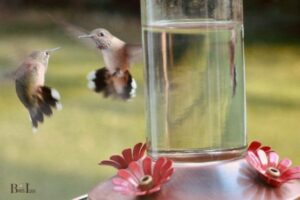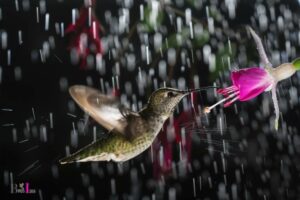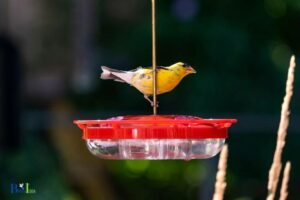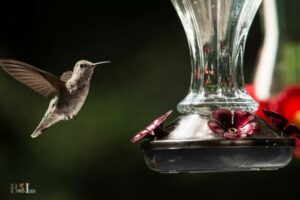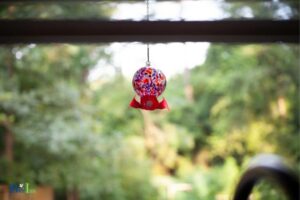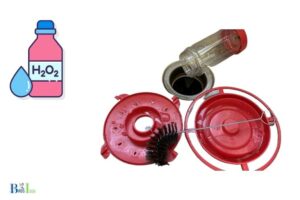How High To Hang A Hummingbird Feeder?
Hang a hummingbird feeder at a height of 4-6 feet above the ground.
Hummingbird feeders should be placed at a height where the birds can easily access it and where it is safe from potential predators.
When hanging a hummingbird feeder, make sure it is placed in a shaded area to prevent the nectar from spoiling in direct sunlight.
Also, ensure the feeder is secure, free from ants by using an ant guard, and cleaned regularly to maintain the health of your visiting hummingbirds.
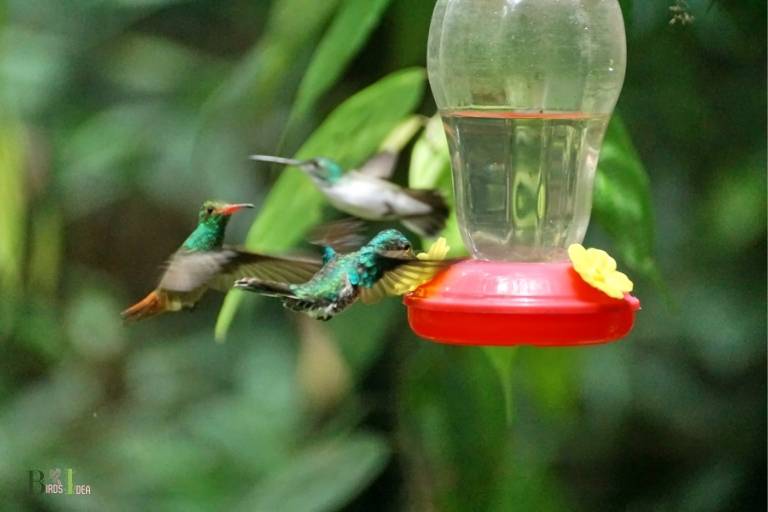
7 Location: High To Hang A Hummingbird Feeder
| Location | Height (in feet) | Reason |
|---|---|---|
| Near Windows | 4-6 | Allows for easy viewing and helps prevent window collisions |
| In Gardens | 6-12 | Attracts hummingbirds to nearby flowers and provides a natural setting |
| Under Trees | 6-12 | Provides shade and protection from predators |
| Near Shrubs | 4-6 | Offers additional perching and hiding spots for hummingbirds |
| Open Yard | 6-12 | Allows for easy access and visibility for the hummingbirds |
| Patios or Decks | 4-6 | Convenient for refilling and maintenance, and close to human activity |
| Near Water Features | 4-6 | Attracts hummingbirds with the sound of running water |
Where Should a Hummingbird Feeder Be Hung?
When hanging a hummingbird feeder, it is essential to consider the height, location, and accessibility for both the birds and the observer.
A well-placed hummingbird feeder can attract various hummingbirds and create an enjoyable experience for those watching them.
- Hang the feeder at a height of 4 to 6 feet (1.2 to 1.8 meters) above the ground
- Choose a location where it can be easily visible to the hummingbirds and human observers (e.g., near a window)
- Place it in a sheltered area with protection from harsh winds and direct sunlight to maintain sugar water freshness
- Position the feeder near flowering plants or trees to provide a natural source of nectar and allow easy access for the hummingbirds
- Maintain a distance from busy pathways or noisy areas to reduce stress for the birds and avoid accidental collisions
- Ensure the feeder is hung securely, as hummingbirds are cautious around unstable objects
By following these suggestions, you will create a welcoming environment for hummingbirds while providing a pleasant viewing experience for yourself and others.
“Hummingbirds prefer to feed at a height of 4 to 5 feet above the ground, which is the average height of most flowering plants.”
Katie Valentine
What’s the Best Height to Hang a Hummingbird Feeder?
To attract hummingbirds and ensure their safety and comfort, it is essential to hang the hummingbird feeder at an optimal height.
The best height to hang a hummingbird feeder is generally between 4 to 6 feet (1.2 to 1.8 meters) above the ground.
By maintaining this height, you can provide an accessible, visible, and safe environment for the hummingbirds while deterring most pests and predators.
Factors to consider when hanging a feeder:
- Visibility: Hang the feeder in a place where hummingbirds can easily see it, preferably near nectar-rich flowers or colorful plants.
- Accessibility: Ensure the feeder is hung in a secure and stable manner, enabling hummingbirds to hover and feed without difficulty.
- Safety: Keep the feeder away from busy areas, predators, and potential hazards, such as windows or doors.
Pro tips:
- Add multiple feeders at varying heights to accommodate various species of hummingbirds and to prevent overcrowding.
- Clean the feeder and replace the nectar regularly to maintain a healthy environment for the hummingbirds.
- Monitor your feeder during the day to discover the hummingbirds’ preferred feeding times and make adjustments if necessary.
By hanging your hummingbird feeder at the ideal height, you can create a pleasant and secure haven for these fascinating birds to visit and enjoy.
What Factors Should Be Considered When Hanging a Hummingbird Feeder?
When hanging a hummingbird feeder, several factors should be considered to create an ideal environment for both the birds and the observer.
These factors include the feeder’s height, location, safety, and accessibility for the hummingbirds.
- Height: Hang the feeder at a height of about 5 to 6 feet above the ground. This height is easily accessible for hummingbirds, and it allows for comfortable viewing for observers.
- Location: Choose a location near flowering plants that provide natural sources of nectar. This will help attract more hummingbirds to the area and encourage them to stay longer. Additionally, consider placing the feeder in a shaded spot to keep the nectar from spoiling too quickly in the sun.
- Safety: Hang the feeder in an area free from potential predators, such as cats or larger birds. Placing the feeder near dense foliage can provide an escape route for hummingbirds in case of danger.
- Accessibility: Ensure that the feeder can be easily accessed for cleaning and refilling. Regular maintenance is essential for keeping the nectar fresh and preventing the growth of harmful bacteria.
Pro tip: Adding multiple feeders in your yard, spaced at a reasonable distance, may help reduce competition among hummingbirds and provide a more peaceful environment for them to feed.
birdsidea
What Is the Optimal Height for a Hummingbird Feeder?
The optimal height for a hummingbird feeder is between four to six feet above the ground. This elevated position allows for easy accessibility for the hummingbirds while also ensuring that the feeder is visible and out of reach for most predators.
The feeder must be hung in a shaded area to protect the nectar from direct sunlight, which may cause it to spoil quickly.
It’s also essential to make sure the feeder is secure and stable to prevent spillage.
- Optimal height: 4 – 6 feet above ground level
- Hang feeder in a shaded area
- Ensure feeder is secure and stable
Pro Tip: Place the feeder near flowering plants, as it will provide an additional food source for the hummingbirds and encourage frequent visits. Additionally, if possible, position the feeder in a location visible from a window or sitting area, so you can enjoy observing these fascinating creatures up close.
birdsidea
What Safety Precautions Should Be Taken When Hanging a Hummingbird Feeder?
When hanging a hummingbird feeder, it’s essential to prioritize the safety of both the birds and yourself.
To ensure a safe and enjoyable environment for the hummingbirds, follow these precautions:
- Height Matters: Hang the feeder at least 4-5 feet above the ground. This height helps to deter predators, such as cats and squirrels, and protect the hummingbirds from potential harm.
- Sturdy Support: Choose a secure branch or pole to hang the feeder from, making sure it can support the weight of the feeder and any visiting birds.
- Away from Windows: Place the feeder at a safe distance from windows to prevent collisions and injuries to the birds.
- Shade and Shelter: Hang the feeder in a shaded area to prevent the nectar from fermenting in direct sunlight, and also provide nearby shelter options such as trees or shrubs for the birds to perch.
- Cleanliness: Regularly clean the feeder and replace the nectar to prevent bacteria and mold growth, which can harm hummingbirds.
How to Hang a Hummingbird Feeder at the Right Height?
Hanging a hummingbird feeder at the right height is crucial for attracting these tiny birds to your garden and providing them with a comfortable and safe environment to feed.
The ideal height for hanging a hummingbird feeder is between 4 to 6 feet above the ground.
This height ensures that the feeder is accessible to the birds while also keeping it out of reach of potential predators.
Key points to consider when hanging a hummingbird feeder:
- Choose a feeder location that offers some shade during the day to keep the nectar from spoiling in the sun.
- Hang the feeder near flowers and plants that hummingbirds are naturally attracted to, such as trumpet vines, fuchsias, and salvia.
- Make sure the hummingbird feeder is visible from the sky, so the birds can easily spot it while flying.
- Keep the feeder at a safe distance from windows to prevent collisions.
Pro tip: To make your garden even more hummingbird-friendly, consider planting native flowers and plants that produce nectar-rich blossoms and provide shelter for the birds. Remember to clean and refill the feeder regularly to ensure the nectar stays fresh and free of bacteria.
birdsidea
Conclusion
In conclusion, the ideal height for hanging a hummingbird feeder is between 5 and 6 feet. This ensures that the feeder is easily accessible to hummingbirds while also keeping it safe from predators such as domestic cats.
When selecting the location to hang the feeder, it’s important to consider the amount of sunlight, wind, and traffic in the area.
It’s also important to keep the feeder clean and well-maintained to prevent the spread of disease.
By following these best practices, you can attract hummingbirds to your yard and ensure their safety and well-being.
TL;DR :
- Hang your hummingbird feeder at a height of 5-6 feet.
- Consider the amount of sunlight, wind, and traffic in the location.
- Keep the feeder clean and well-maintained to prevent the spread of disease.
Action list:
- Choose a location to hang the feeder with ample sunlight and minimal wind and traffic.
- Hang the feeder at a height of 5-6 feet to keep it easily accessible to hummingbirds and safe from predators.
- Clean and maintain the feeder regularly to ensure the health and safety of the hummingbirds.
According to a study conducted by the Audubon Society, hummingbirds are most attracted to feeders hung at a height of 4 to 5 feet above the ground, with an east-facing orientation to avoid direct sunlight.
birdsidea
FAQ for High To Hang A Hummingbird Feeder
How high should I hang a hummingbird feeder?
Should I hang my hummingbird feeder in a shady area?
Is it okay to hang multiple hummingbird feeders in one location?
Is it important to clean the hummingbird feeder regularly?
Where is the best place for a hummingbird feeder?
If you’re a bird lover looking to attract hummers to your yard, you might be wondering about the ideal spot to place your feeder.
The location of your hummingbird feeder is critical to entice these tiny birds and keep them safe and happy. The previous heading, “how high to hang a hummingbird feeder?” is just one aspect of placement.
Here are some other tips for positioning your feeder in the best possible spot:
- Hang your feeder in a shady area to prevent the nectar from spoiling too quickly.
- Place the feeder in close proximity to flowering plants or shrubs to offer hummers natural food sources and protect them from predators.
- Opt for a spot where you can observe the birds from indoors, such as near a window or on a patio.
- Keep the feeder at a sufficient height to guarantee birds’ safety but easy enough to clean and refill.
Overall, the ideal location for a hummingbird feeder is one that provides these nectar-loving birds with their favorite food while also keeping them safe from harm.
- Hummingbirds are attracted to the color red, so consider buying feeders with red flowers or decorations.
- Make sure your feeder is in a spot that is visible but not too close to windows or reflective surfaces, as birds may accidentally fly into them.
- Regularly clean your feeder to avoid mold and bacteria build-up that can be harmful to the birds.
Where should you not hang a hummingbird feeder?
While there are places where you should hang a hummingbird feeder, it’s also essential to know where not to hang it as it can prevent hummingbirds from visiting your feeder.
Hummingbirds require a peaceful environment to feed, and placing a feeder in a location that could cause distress or danger could deter them from visiting your feeder.
Here are some places where you should not hang a hummingbird feeder:
- Near a window that reflects the sky, trees or flowers, or indoors
- In direct sunlight for more than half a day
- Close to wind chimes or other noisy objects that could scare them away
- In an area with lots of ants or bees
Be mindful of your feeder’s placement for the safety and well-being of the hummingbirds, and they will reward you with stunning displays of aerial acrobatics.
- Avoid hanging hummingbird feeders next to ant-infested areas to avoid losing food to the pests.
- It would be best to avoid hanging hummingbird feeders close to areas with excessive human activity to make the birds feel safe and prevent disturbances.
- Hummingbird feeders must be placed in areas with natural cover such as shrubs or trees, creating a peaceful environment for the birds.
How do you hang a homemade hummingbird feeder?
If you’re using a homemade hummingbird feeder, you may be wondering the best way to hang it up in your yard. Luckily, it’s quite simple to do!
Here are the steps you can follow:
- Find a location that’s easy to see and in a shady spot.
- Using a screwdriver or drill, make a hole in the lid of the feeder.
- Thread a piece of wire through the hole and make a loop at the end.
- Hang the loop on a hook or nail, ensuring it’s sturdy and won’t wobble around.
By following these steps, you can easily hang up your homemade hummingbird feeder, and enjoy watching these stunning little birds come and feed in your garden. Make sure your feeder is high enough to keep it away from squirrels and other animals.
Where should I hang my bird feeder?
If you’re planning to hang a bird feeder in your backyard, it’s important to choose an appropriate location to ensure that the feeder attracts birds and doesn’t create any unwanted problems.
The first and foremost requirement is to maintain a distance from any obstacles, such as trees, buildings, or fences, which may give easy access to predators.
Additionally, the feeder must be placed in an area where birds can easily spot it and have easy access to food. One of the most effective ways to accomplish this is by hanging the feeder in a high traffic area, where birds can see it from a distance.
You may want to experiment with a few different locations to find the perfect spot that works for your garden and attracts the most variety of birds.
Here are some additional tips to keep in mind when hanging a bird feeder:
- Choose a spot that is easily visible from your window so you can observe the birds and enjoy their beauty.
- Make sure to keep the feeder clean and your feeding area tidy to prevent the spread of diseases or attracting pests.
- Use a sturdy hanger or pole and make sure that it’s properly secured to avoid any accidents.
- Provide different types of feeders to attract different types of birds and offer different types of food suited for their diet.
This is often used in the design of bird feeders to attract specific birds by using their favorite colors.
What size hummingbird feeder is best?
If you’ve decided to add a hummingbird feeder to your backyard, you may be wondering what size is suitable for these tiny creatures.
Whether you are a novice or an experienced birdwatcher, choosing the right size feeder can have a significant impact on the birds’ feeding patterns and your overall birdwatching experience.
One crucial factor to keep in mind is the height of the feeder. Ideally, the feeder should be hung at eye level or slightly higher, making it easier for you to see the birds and allowing them to feed at their preferred height.
Additionally, it is essential to place the feeder in a shaded area to prevent the nectar from spoiling.
Hummingbirds are incredibly active and need to consume a lot of food, so they tend to feed frequently, which means you’ll need to refill the feeder often.
- The recommended size for a hummingbird feeder is between 8-16 ounces.
- A larger feeder means more nectar, which can spoil and attract unwanted insects.
- A smaller feeder may need to be refilled more frequently, but it offers a more suitable environment for the birds.
- Consider purchasing a feeder with bee guards to prevent bees and other insects from drinking the nectar.
In conclusion, finding the best size hummingbird feeder comes down to your preferences and the birds’ feeding patterns in your area.
Choose a feeder that’s easy to refill and clean, hang it at the right height, and place it in a shaded area to keep the nectar fresh.
With the right feeder and location, you’re sure to attract a range of hummingbirds to your backyard, providing endless entertainment and a unique natural experience.
How to attract and keep birds coming to your feeder?
One effective way is to offer them a reliable source of food through a bird feeder. But it’s not just about setting up a feeder and hoping for the best. To attract and keep birds coming to your feeder, there are several important factors to consider.
Here are some tips on how to attract and keep birds coming to your feeder:
- Choose the right feeder based on the bird species you want to attract. For example, tube feeders are great for attracting small birds like finches and chickadees, while hoppers and platform feeders are better suited for larger birds like cardinals and jays.
- Offer a variety of foods to cater to different bird species. Black oil sunflower seeds and suet are popular options that attract a wide range of birds.
- Keep your feeder clean and well-maintained to prevent the spread of diseases among birds.
- Place your feeder in a location that is easily accessible for birds but also safe from predators like cats and squirrels.
By following these tips and providing a welcoming environment for birds, you can enjoy the beauty and delight of these feathered friends in your own backyard.
- Offer different types of feeders to cater to different bird species
- Fill your feeder with a variety of foods to attract birds
- Clean your feeder regularly to prevent the spread of diseases
- Place your feeder in a safe location for birds and away from predators
- Keep a consistent feeding schedule to establish a routine for birds

